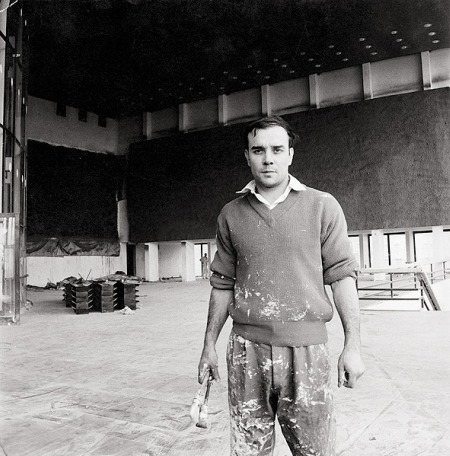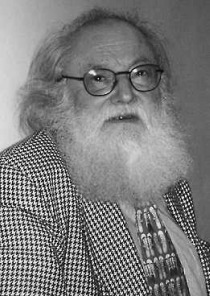
Sleepers Awake
Not all museums are asleep. Some are trying to rope in customers by stealth or educational and internet outreach. Certainly the most innovative ploy is the Hirshhorn Museum’s new effort, led by a Facebook experiment. A daily Facebook entry offers Yves Klein information-nuggets, up to the opening day of “Yves Klein: With the Void, Full Powers” (Washington, D.C., May 20 to Sept. 12).
Not a member of Facebook? Reading this entry after May 20? Never fear. You can access the installments on the Hirshhorn website by going to the Yves Klein Material Archive. So far, as of this writing, both the English translation of a 1957 radio interview and the one minute of Klein’s own Judo film are essential.
What I call Twitter-koans can also be accessed through the Archive — and, of course, on twitter.com itself. Although Klein was not a Zen adept, his mastery of Judo brings him “almost close,” and thus his pithy conundrums are entirely appropriate for Twitter
Examples:
“Judo has helped me to understand that pictorial space is above all the product of spiritual exercises.”
“Each defeat must be seen as an important step towards the final victory.”
“Through color I feel the sentiment of complete identification with space; I am truly liberated.”
So far, the above mentioned Judo footage plus a doc-clip about Klein’s sponge mural for the Gelsenkirchen Opera House can be seen on the Hirshhorn’s YouTube site.
And on Flickr, many, many documentary images are on display.
The Hirshhorn’s Klein offerings are now the gold standard of museum internet outreach.
Mutant
If you don’t already know about Yves Klein (1926-1962), you can also read the previously posted Artopia entry. To summarize, he was a visionary. He was the first to exhibit an empty gallery. He patented Yves Klein International Blue. He claimed that no two all-blue paintings were alike. And so forth.
The French critic Pierre Restany (1930-03), Klein’s most serious promoter — and the mastermind of Nouveau Réalisme (Klein, Jean, Daniel Spoerri, Arman, et al.) — in his 1973 text, published in English in 1984, presents Klein as a mystic and, yes, a mutant:
He was a painter, but also infinitely more: a believer living in his own sense of the divine, and a mutant responsible in the highest degree for the future of his vision.
Actually, he lived the tense and secret existence of an initiate who believed in the close harmony between God and Science, of a mutant integrated into Western society, perfectly conscious of the immense possibilities of industrial civilization, and determined to offer it other motivations besides those connected with the search for immediate profit…. [My emphasis.]
 Pierre le Fou: Mastermind
Pierre le Fou: Mastermind
Pierre himself, I can testify, was quite a charmer. I met him in the ’60s, introduced by fellow critic and noted anthologist Gregory Battcock. Restany in turn introduced me to Lygia Clark, the Brazilian luminary then living in Paris as an exile from the Brazilian military government. We shook hands, which was her artwork. Restany, by the way, always gave Klein credit for his own spiritual turn.
Searching for the “mutant” ammunition, I skimmed Restany’s chapter on the “One Day of Art” newspaper. Klein’s Dimanche (Sunday), was available at Paris newsstands on Sunday, November 27,1960. The headline was A MAN IN SPACE and the subhead “The Painter of Space Casts Himself Into the Void” acted as a caption for the famous Leap photo-collage.
In honor of Yves Klein’s “leap,” Nov. 27, as you may or may not know, is now widely celebrated as Artopia Day.
But the other offerings, usually “avoided” I think because they concern theater, are inflammatory too:
Here again is part of Klein’s front-page editorial
…I have decided to present an ultimate form of collective theater on Sunday for everybody….The theater of operations that I propose is not only the city, Paris, but also the countryside, the desert, the mountains, the sky, and the whole universe itself. Why not?
Elsewhere: “The future of theater is an empty auditorium; it is no longer an auditorium at all.”
Nevertheless, Klein had many theater projects in mind, including: (1) a theater piece that involves tying up and gagging each member of the audience, (2) a theater-by-subscription presenting a program of changing light to one subscriber at a time, (3) an hallucinogenic pill that makes you dream blue.
And Restany describes:
The play about “thieves of ideas” deals with the problem of relations among mutants living in the technical Eden. Their sensitivity allows them to overstep the bounds of individual privacy and “to dream reciprocally in the dreams of others,” just as today individuals who are sufficiently perceptive “steal ideas that are in the air.” [My emphasis.]
These proposals go far beyond the body-painting event sensationalized in the film Mondo Cane, at the debut screening of which Klein had the first of three heart attacks that rapidly caused his premature demise at the age of 34. And now he is resurrected via the internet.

Art Online
Other museums are trying to snare more hits on the internet, but some are surely falling behind. Here are a few for your perusal.

Difficult site to navigate. There is so much to cover in terms of exhibitions and events. But does it have to be confusing?
Nevertheless, for the duration of the Abramović exhibition you can see her stare-down live (although almost pixilated). Same place, same station, various video interviews are offered — Marina gently questioned by curator Klaus Biesenbach, including “Performance v. Acting.” Biesenbach is now trying to fill Alanna Heiss’ shoes as the new director of MoMA/P.S.1.
You can access a great deal of the permanent collection and find out some interesting facts, like who gave what and when. If you register, you can “save works of art in the collection.” Are they in danger? No, I think they mean save images of your choice on your own computer. But isn’t this the same as “Register to create and annotate artwork sets”?
If you have patience, you can search for a list of Board Members and recent audited financial statements. How you interpret the numbers depends upon your skills as an accountant, nonprofit administrator, or hired detective. But they are there for all to see. Secret: the tiny ABOUT to the right on the upper band.

2. Whitney Museum of American Art
The Whitney site makes it easier than MoMA to curate your own exhibition, derived from their holdings. You simply log in, and then its all up to you. An all-woman show? An exhibition of artists over 65? Artworks state-by-state? Acquisition mistakes? All things are possible.
Image Ratio [works online : works on view] — For the Biennial 1:1. There’s an image or a video for each artist. And a Wiki page was offered to Biennial artists, but with only 15 takers.
In March, the Whitney promoted a virtual tour for 8 lucky applicants who would Twitter, Tweet, and Face the Biennial, normally off-limits to cameras, alas.
I can find no public results, except the N.Y.Times announcement.
In small type at the bottom of the introductory page you will you find ABOUT. Click to ADD LINKS find Board of Trustees and narrative biographies of the staff. No annual reports or financials, though.

The Indianapolis under Maxwell Anderson, former director of the Whitney (1998-2003), has a policy of transparency that is admired and celebrated within the museum community. The Indianapolis does not just post financials, but entire annual reports for the past eight years, plus three recent IRS returns. Even nonprofits must report to Uncle Sam. Go to ABOUT. Click: DASHBOARD. Or to INTERACTIVE and then DASHBOARD. Or (!) just click here.
It is the well-designed DASHBOARD that does most of the work. It gives out a lot of information in a digestible way: number of works on loan, number of works on view, size of endowment, attendance (107,717 so far this year), memberships (9,395), donations, expenses, even energy consumption (47,389 KWH per day).
There is even a list of senior staff — by the way, not anywhere apparent on the MoMA site. Bravo Indianapolis! And of course the museum indulges in all sorts of social media like Twitter.
Image ratio: The current exhibition of Tara Donavan installations is represented by 15 images and a video.

4. Los Angeles County Museum of Art
LACMA has its Twitter offering on its opening page, but otherwise not much multimedia or internet use interface. The “blockbuster” Renoir (ugh) exhibition is represented by a slideshow of only nine images, and I couldn’t find videos anywhere. Not a very good image-to-artwork ratio. Oh, I forgot: a 10- minute Film Club speech by Clint Eastwood.
In terms of transparency: click on LACMA for full list of trustees, recent financial statements and IRS 990s. No staff list.

The Met, like MoMA, has a lot of programming to organize. Website navigation is fairly easy. The site also has the Heilbrunn Timeline of Art History, which is organized by time period and geography. Well, you have to start somewhere.
Some exhibitions, like the current and boring show of Picasso artworks from the Met’s collection — 300 out of 486, which makes it seem that the exhibition was merely moved from storage, rather than curated — have images of every artwork (and more), plus an explanatory video (director Thomas Campbell chatting with curator Gary Tinterow); others have scant image representation and no video. The 14-painting “Contemporary Aboriginal Painting From Australia” only has four images online and no video, meaning, I suppose, it is a kind of throw-away.
Image ratio: variable. [Picasso: 1:1; Aboriginal Paintings: 1:2.5].
I was delighted that if you go to ABOUT THE MET you can find a full staff list and annual reports. But the Met website is not internet or multimedia heavy — rather lean, actually, for such a large educational institution.
In the meantime, you may want to deconstruct the Heilbrunn Timeline and accompanying texts. For instance, in the section “The United States and Canada, 1900 A.D. –present”, in the Overview text neither women’s suffrage nor the U.S. civil rights movement is mentioned, never mind feminism and gay liberation. Radio, motion pictures, and television are not cited as influences upon art, to make room I suppose for the glorification of computers in the last paragraph of this weird condensation. Then again, neither Abstract Expressionism, Pop Art, Minimalism nor Conceptual Art are mentioned either. Is this a case of the over-determination of simplification, or is it “history” determined by artworks at hand (in the Met collection) rather than allowing artworks to be seen in the context of history? Also: Why a timeline for Canada? Does the Met have so many Canadian artworks? Oh, I see, this is North America. If Canada, why not Mexico? Perhaps Canada is really part of the United States. Perhaps Mexico does not exist.
* * *
The MoMA Syndrome
And now, skeptics might ask, with all these images on the internet, why should we bother going to museums? Just — as some propose — free news on the internet is killing print-on-paper news, will free art on the internet murder museums? Well, free and easy access to news and opinion is not the only thing killing print; bad writing, bad editing, and bad reporting play a big part too.
If the idea is the important thing about an artwork, why bother seeing the stuff first-hand? If the image is the message, why make an effort to see the template in the temple? Art history is most often taught through projected images, so why not experience art in the same way, from beginning to end, in the comfort of your home computer or on the go on your smartphone. Less wear and tear on the art. Of course, some institutions routinely substitute replicas. Certainly not the museums mentioned above — but replication can be so good, who would know?
I still think that what was made to be seen in the flesh should, if at all possible, be so seen.
Then there is the squishy middle ground: a great deal of contemporary art is made with the artist looking over his or her shoulder at media. Art must be photogenic.
Some of it is improved by media and, I would say, fulfilled by media. In some sense, there is no “original,” or its originality is trivial. One may wonder, however, if an image of an image can still have aura. Well, sometimes tin saints do.
I am not necessarily pointing at Conceptual art, for some of that depends upon context. One word in an empty museum is experienced differently from the same word seen in the middle of a computer screen.
Although there may soon be a yearning for tactility and physicality, I wouldn’t count on it lasting too long. The future of art is on the internet.
So what should museums do? Seeing digitalized images before you see the real thing can prepare you, tempt you to visit, or warn you away; seeing them afterward can be an aide–mémoire or an opportunity to think, removed from churning, chatting crowds. However….
Everyone knows what the Stendhal Syndrome is. But perhaps you have never heard of the Paris Syndrome. A seductive lead to a review of a travel book cited this newly identified malady. First time visitors to Paris — mostly Japanese, it would seem, to the tune of 20 a year — sometimes swoon and become ill when they see the real Paris, with traffic, garbage, other tourists and so forth, as opposed to the Paris they have fantasized.
There is also something I will call the MoMA Syndrome: some first-time visitors to MoMA, wherever they are from, swoon and faint because the art they see does not live up to the perfection of full-color reproductions and slide presentations they have already viewed. That Pollock or Picasso is too small. That Barnett Newman is too messy. The ceilings are too low, and there are far too many people crowding in front of each painting. Is that really how a Monet looks?
Want to discuss this? Go to John Perreault’s Artopia on Facebook, for the discussion topic: Will the internet destroy art?
Also, JohnPerreault can now be “followed” on Twitter, where the offering will be appropriately pithy, twittery Art Quotes. Sample: “Art is either plagiarism or revolution.” (Paul Gauguin).
FOR AN AUTOMATIC ARTOPIA ALERT WHEN A NEW COLUMN IS AVAILABLE: perreault@aol.com
